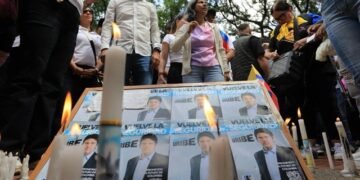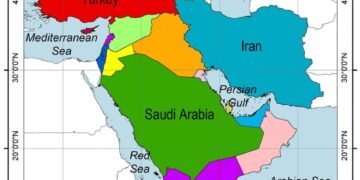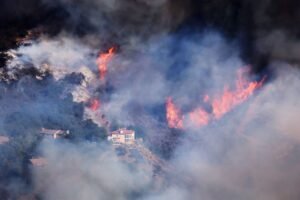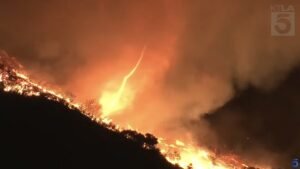As wildfires in Southern California carved a path of destruction, local officials and experts were left grappling with an urgent question: Could this unprecedented devastation have been mitigated, or is this now the unavoidable reality in an era of climate-driven disasters? While there is no singular answer, a detailed review of expert opinions and government reports suggests that the devastation stems from a combination of uncontrollable natural forces and preventable human shortcomings.
The Perfect Storm of Fire Conditions
Described as a “perfect storm” by Los Angeles city and county officials, the fires were driven by hurricane-strength winds exceeding 100 mph, combined with parched landscapes and simultaneous outbreaks across multiple locations. These conditions created an unstoppable force that overwhelmed firefighting efforts. Experts agreed that the scale of destruction was largely inevitable under such circumstances, but highlighted missed opportunities to reduce its impact.
The fires consumed more than 55 square miles, destroyed thousands of structures, and claimed at least ten lives. As the flames subsided, officials began investigations to understand how the situation escalated and what improvements could be made to prevent such a catastrophe in the future.
Water Supply Challenges in Firefighting
One critical factor under scrutiny is the availability and reliability of water for firefighting. During the fires, firefighters repeatedly reported a loss of hydrant pressure, severely hampering their ability to combat the flames. Some neighborhoods, including Pacific Palisades, experienced “dry hydrants” as storage tanks emptied due to unprecedented demand. These tanks, designed for urban firefighting, struggled to sustain the extended, high-volume usage required during the wildfire emergency.
The Palisades fire alone created a fourfold increase in normal water demand for over 15 hours. Compounding the crisis, a nearby reservoir was undergoing repairs and stood empty during the fire, further depleting resources. In Altadena, gravity-reliant water systems failed when electrical power—necessary for pumping water into high-elevation tanks—was shut off to protect firefighters from fallen power lines.
Greg Pierce, a water-resource expert at UCLA, emphasized that no water system could fully withstand such an extreme event, but functioning hydrants might have saved individual structures or reduced the spread in isolated areas.
Resource Constraints and Budgetary Cuts
Los Angeles firefighting capabilities have also been strained by years of budget cuts and resource shortages. Los Angeles City Fire Chief Kristin Crowley cited reduced staffing, funding for training, and fire prevention programs as critical weaknesses. A memo from Crowley to Mayor Karen Bass highlighted that funding reductions had severely limited brush clearance inspections, a key fire prevention measure.
Mayor Bass defended the cuts, explaining that they were made during challenging economic times, but critics argue that such decisions compromised the city’s ability to respond to emergencies. While additional funding has been allocated, the gap between current resources and what is required remains significant. Crowley has warned that the fire department is “screaming to be properly funded” to address year-round fire threats exacerbated by climate change and urban expansion.
The Role of Building Codes and Urban Planning
California’s stringent wildfire building codes, introduced in 2008, have proven effective in protecting homes built under these regulations. However, the vast majority of homes in fire-prone areas predate these codes and remain vulnerable. Studies show that homes built after 2008 are significantly less likely to be destroyed, but retrofitting older structures remains prohibitively expensive and logistically challenging.
In addition to structural improvements, neighborhood design and planning play a crucial role in reducing fire risk. Programs encouraging residents to clear brush, improve evacuation routes, and adopt fire-resistant landscaping are being promoted, but implementation has been slow. In Pacific Palisades, efforts to create fire-safe councils and secure grants for community fire prevention measures were underway but had not yet materialized before the fires struck.
Climate Change and the Increasing Frequency of Fires
As fire seasons lengthen and intensify due to climate change, experts are calling for more proactive measures to address the risks. Beyond immediate firefighting efforts, investments in infrastructure, such as burying power lines and upgrading water distribution systems, could reduce vulnerabilities. These measures, however, require significant funding and political commitment.
Some researchers suggest that managed retreat—encouraging residents to relocate from high-risk areas—may be a necessary strategy in the face of escalating fire risks. Although controversial, this approach recognizes that rebuilding in fire-prone zones may not be sustainable in the long term.
Looking Ahead: Learning from the Flames
While the catastrophic winds were the primary driver of destruction, the fires exposed critical weaknesses in emergency preparedness, infrastructure, and resource allocation. Officials are now tasked with addressing these shortcomings to better protect communities in the future.
In the aftermath of the fires, rebuilding efforts must prioritize resilience, incorporating stricter building standards, improved water systems, and enhanced disaster planning. As California continues to face the realities of climate change, the lessons learned from this disaster may shape how communities prepare for and respond to the growing threat of wildfires.

 English
English








































